Operation Midnight Hammer was a major American military strike on June 21-22, 2025, targeting three principal Iranian nuclear sites: Fordow, Natanz, and Isfahan. The operation saw the first operational deployment of the 30,000-pound GBU-57/B Massive Ordnance Penetrator (MOP) bunker buster bombs and involved a sophisticated and highly coordinated air campaign aided by a guided missile submarine and various support aircraft.
Timeline of Operation Midnight Hammer
June 20, 2025, Midnight (Saturday to Friday): Seven B-2 Spirit stealth bombers left Whiteman Air Force Base in Missouri, flying east for about 18 hours with reduced communications in order to preserve tactical surprise. A portion of the force headed westward into the Pacific as a diversion.
Early morning hours of June 21, 2025 (approximately 2:10 a.m. local Iranian time): The B-2 bombers started hitting the Fordow and Natanz nuclear facilities by launching a total of 14 MOP bombs within approximately 25 minutes. The Isfahan facility was also hit by well over two dozen Tomahawk land attack cruise missiles (TLAMs) fired by a U.S. Navy Ohio-class nuclear-powered guided missile submarine operating in the area.
Post-strike: The strike package left Iranian airspace and headed back home without facing Iranian fighter aircraft or surface-to-air missile threats, testifying to the stealth and accuracy of the operation.
Objective
The overall goal of Operation Midnight Hammer was to neutralize the threats presented by Iran's nuclear program to U.S. national interests and the collective defense of U.S. forces and the ally Israel. The operation intended to severely damage Iran's buried nuclear enrichment capacity, and most importantly, the Fordow site, which was the main target.
Results
Initial estimates of battle damage reported "extremely severe damage and destruction" on all three targeted facilities. The Fordow plant was severely damaged, with huge craters and obstructed tunnel entrances visible in satellite images, though the facility was not destroyed.
The Natanz and Isfahan plants were badly damaged as well. The Isfahan plant was hit with Tomahawk missiles, the first coordinated multi-platform attack.
The operation successfully demonstrated the U.S. capability to penetrate deeply buried and fortified nuclear sites using the MOP bombs and showcased a high level of operational security and precision.
Aftermath
The U.S. Pentagon continues to conduct detailed battle damage assessments, but the initial reports suggest the operation achieved its intended effects.
There was no direct Iranian military reaction reported throughout the operation, although regional tensions remained elevated, and fears of counter-attack against U.S. military bases in the Middle East existed.
The operation was followed by coordination with Israel, which had previously conducted attacks on Iranian military and nuclear facilities, raising the level of existing tensions in the region.
Donald Trump Statements
President Donald Trump publicly announced Operation Midnight Hammer a "spectacular military success," highlighting that Iran's nuclear enrichment plants had been "completely and totally obliterated."
. @POTUS “A short time ago, the US military carried out massive precision strikes on the three key nuclear facilities in the Iranian regime...
— DOD Rapid Response (@DODResponse) June 22, 2025
Our objective was the destruction of Iran’s nuclear enrichment capacity and a stop to the nuclear threat posed by the world’s number… pic.twitter.com/GNLmV0gfXw
Speaking in a televised address, Trump threatened Iran to bring peace soon or risk further attacks with "speed" and "precision," declaring, "This cannot continue. There will be either peace or there will be tragedy for Iran, far greater than we have witnessed over the last eight days.".
Trump also tweeted on Truth Social implying that if the existing Iranian government was unable to "MAKE IRAN GREAT AGAIN," then a change of government could be justified, showing a hardline approach after the operation.
The White House informed congressional leaders after the operation, with bipartisan demands made to apprise them of the success and extent of the mission.
